Abstract
Microbial toxins act through cyclic nucleotide dependent (cAMP or cGMP) or cyclic nucleotide independent pathways to cause intestinal ion secretion. To explore the calcium dependent, cyclic nucleotide independent pathway that is postulated to involve protein kinase C activation, we measured protein kinase C activity and phorbol ester binding in isolated intestinal epithelial cells and examined the effects of the C-kinase activators, phorbol myristate acetate, phorbol dibutyrate, and 4-beta-phorbol-12,13-didecanoate, in weaned pig jejunum in vivo. We demonstrated both protein kinase C activity and specific phorbol ester binding in porcine jejunal epithelial cells. Phorbol myristate acetate, phorbol dibutyrate, and 4-beta-phorbol-12,13-didecanoate (10(-5) M) each caused striking secretory responses at 5 h with accumulation of Na+, K+, Cl-, and HCO3- intraluminally. In contrast, 4-alpha-phorbol and 4-alpha-phorbol-12,13-didecanoate, which do not affect protein kinase C, allowed normal net absorption of all electrolytes from the intestinal lumen equivalent to controls with only Ringer's lactate. Time course studies revealed significant secretion within 30 min after exposure to the C-kinase activators. These data suggest an important role for protein kinase C activation in intestinal ion secretion.
Full text
PDF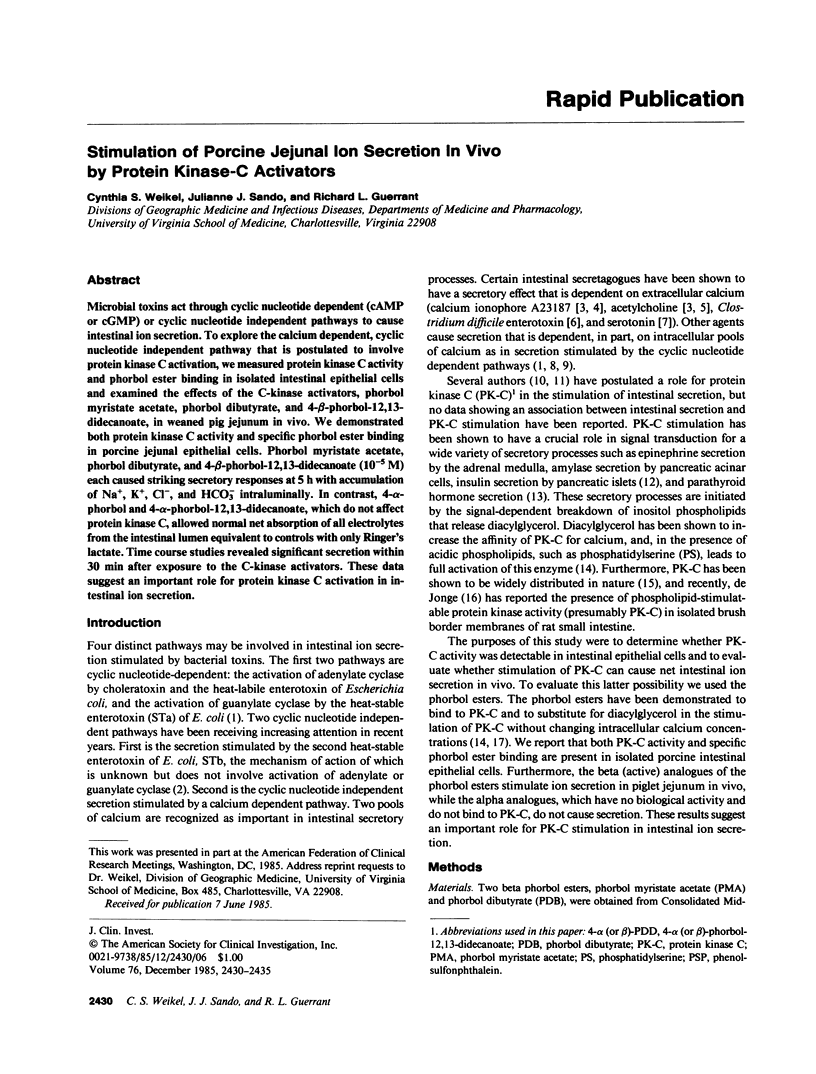
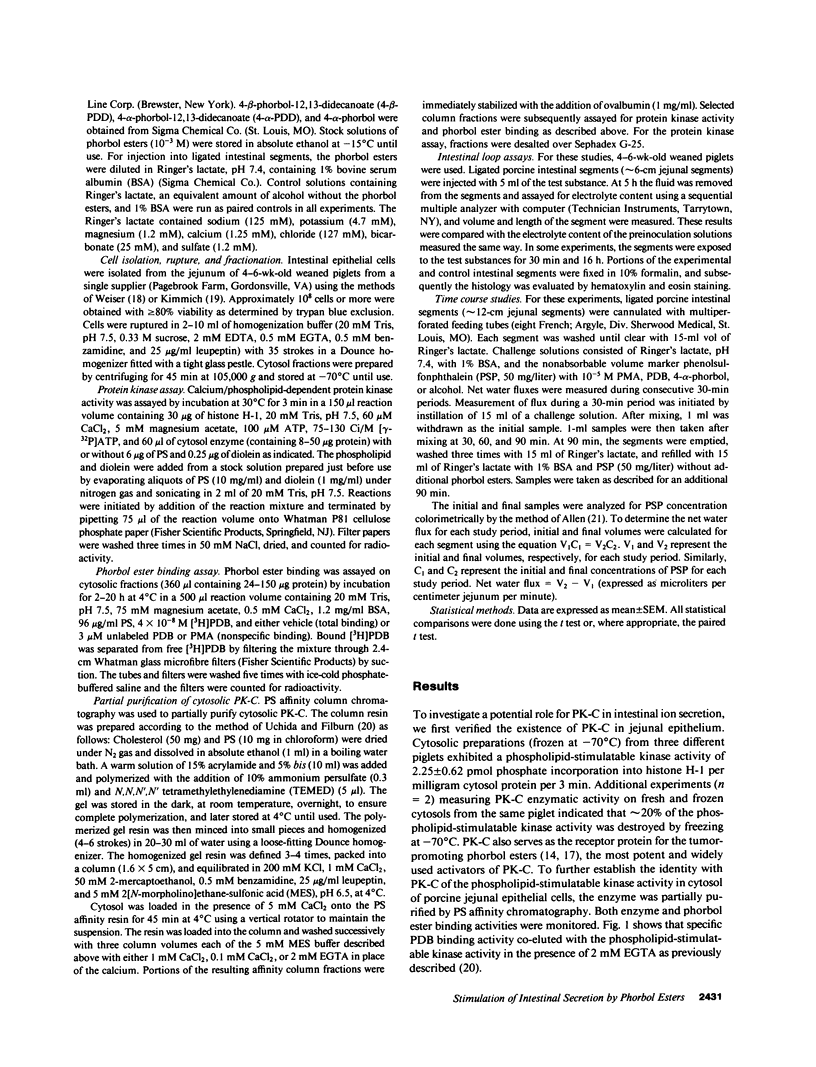
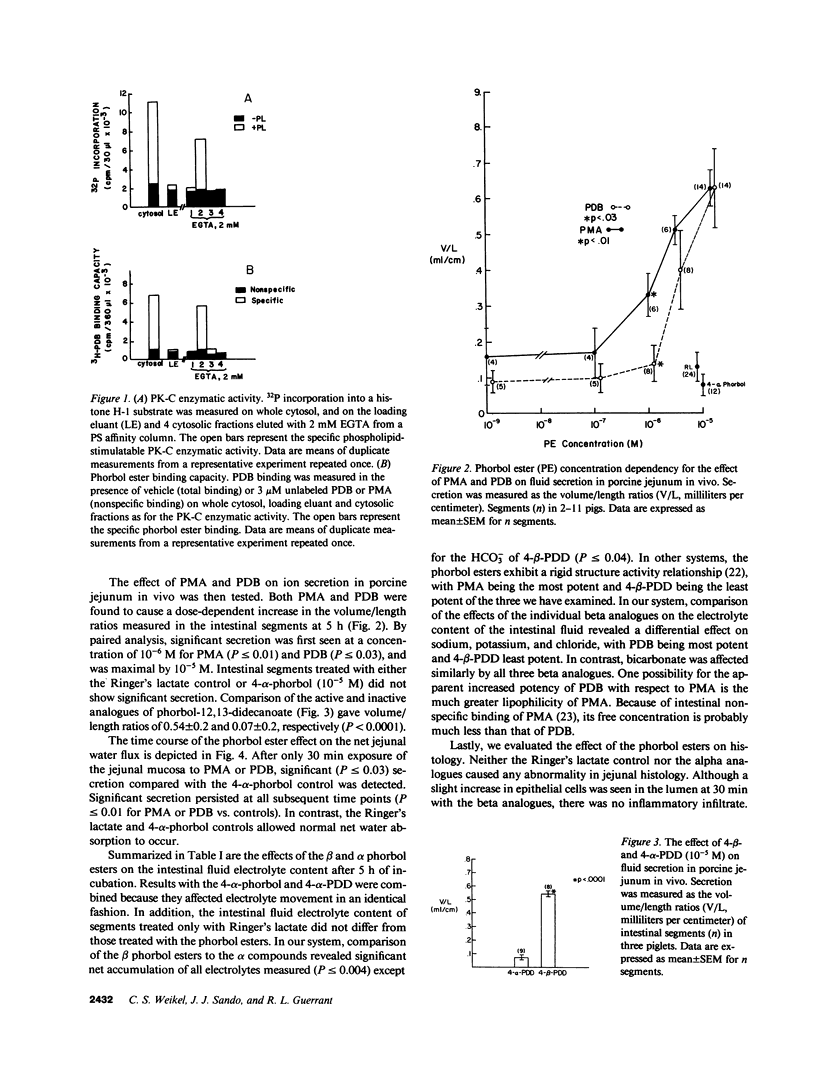
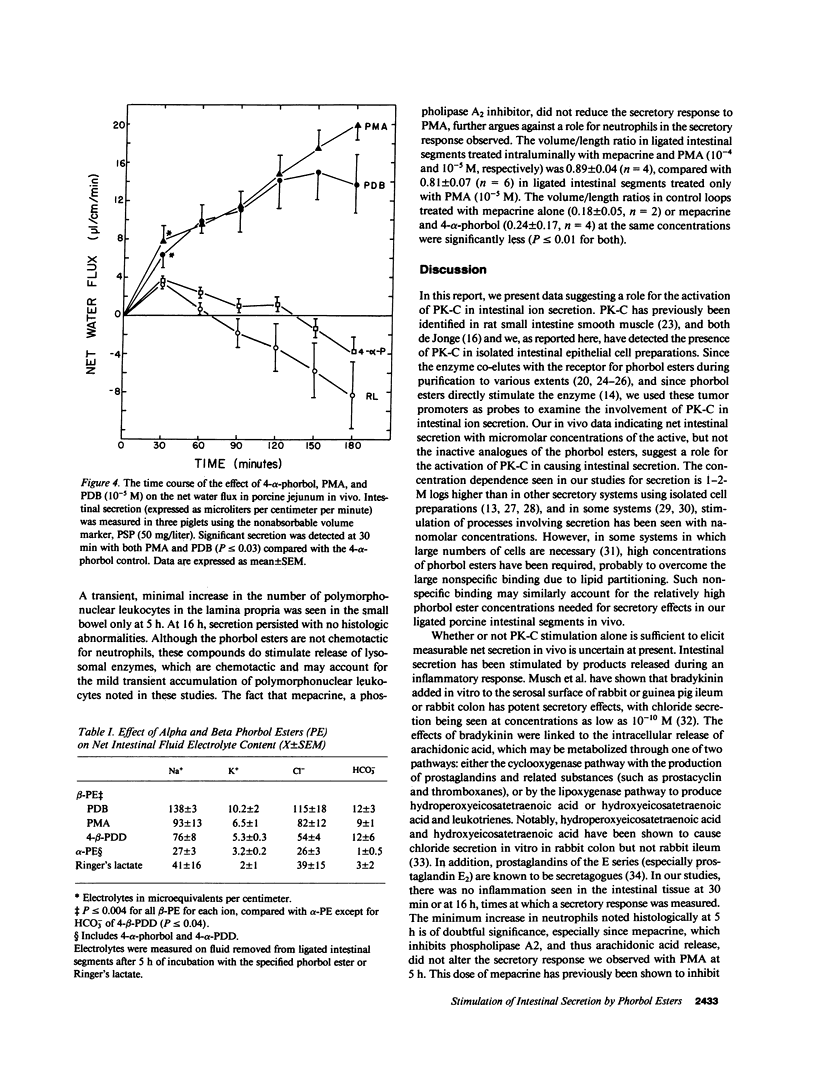
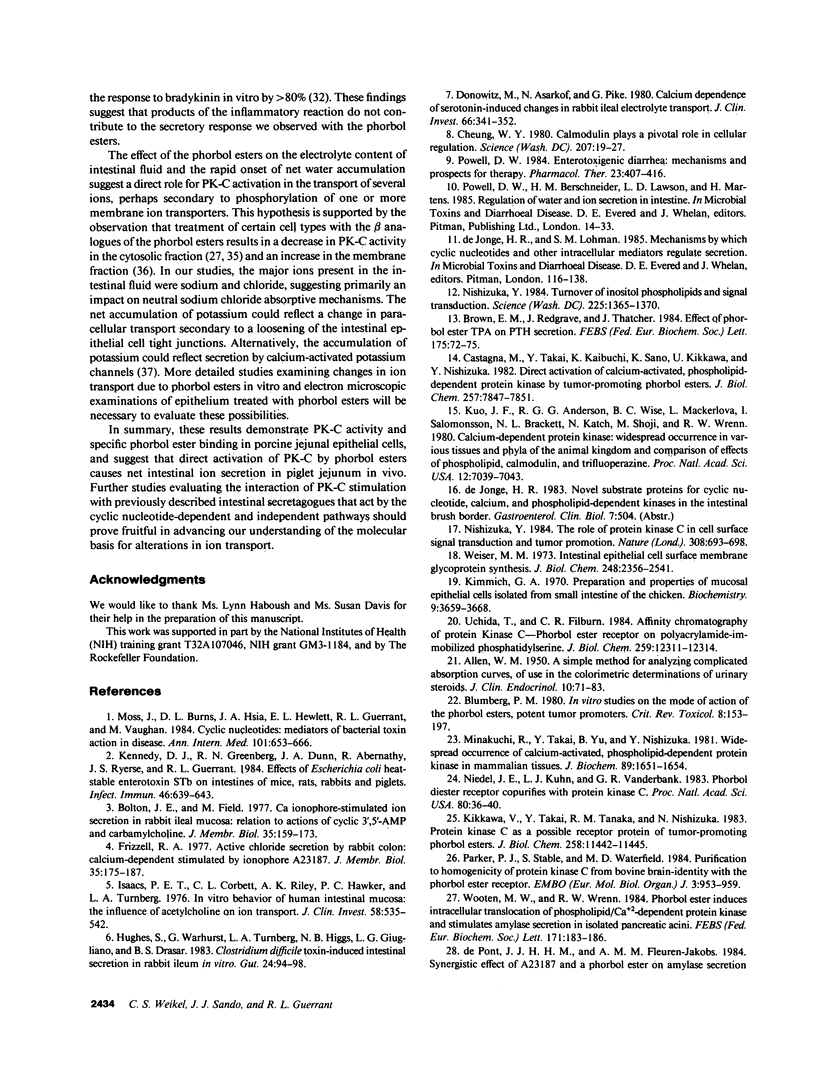

Selected References
These references are in PubMed. This may not be the complete list of references from this article.
- Blumberg P. M. In vitro studies on the mode of action of the phorbol esters, potent tumor promoters: part 1. Crit Rev Toxicol. 1980 Dec;8(2):153–197. doi: 10.3109/10408448009037493. [DOI] [PubMed] [Google Scholar]
- Bolton J. E., Field M. Ca ionophore-stimulated ion secretion in rabbit ileal mucosa: relation to actions of cyclic 3',5'-AMP and carbamylcholine. J Membr Biol. 1977 Jun 30;35(2):159–173. doi: 10.1007/BF01869947. [DOI] [PubMed] [Google Scholar]
- Brown E. M., Redgrave J., Thatcher J. Effect of the phorbol ester TPA on PTH secretion. Evidence for a role for protein kinase C in the control of PTH release. FEBS Lett. 1984 Sep 17;175(1):72–75. doi: 10.1016/0014-5793(84)80572-4. [DOI] [PubMed] [Google Scholar]
- Castagna M., Takai Y., Kaibuchi K., Sano K., Kikkawa U., Nishizuka Y. Direct activation of calcium-activated, phospholipid-dependent protein kinase by tumor-promoting phorbol esters. J Biol Chem. 1982 Jul 10;257(13):7847–7851. [PubMed] [Google Scholar]
- Cheung W. Y. Calmodulin plays a pivotal role in cellular regulation. Science. 1980 Jan 4;207(4426):19–27. doi: 10.1126/science.6243188. [DOI] [PubMed] [Google Scholar]
- Donowitz M., Asarkof N., Pike G. Calcium dependence of serotonin-induced changes in rabbit ileal electrolyte transport. J Clin Invest. 1980 Aug;66(2):341–352. doi: 10.1172/JCI109862. [DOI] [PMC free article] [PubMed] [Google Scholar]
- Field M., Musch M. W., Stoff J. S. Role of prostaglandins in the regulation of intestinal electrolyte transport. Prostaglandins. 1981;21 (Suppl):73–79. doi: 10.1016/0090-6980(81)90121-0. [DOI] [PubMed] [Google Scholar]
- Frizzell R. A. Active chloride secretion by rabbit colon: calcium-dependent stimulation by ionophore A23187. J Membr Biol. 1977 Jun 30;35(2):175–187. doi: 10.1007/BF01869948. [DOI] [PubMed] [Google Scholar]
- Garrison J. C., Johnsen D. E., Campanile C. P. Evidence for the role of phosphorylase kinase, protein kinase C, and other Ca2+-sensitive protein kinases in the response of hepatocytes to angiotensin II and vasopressin. J Biol Chem. 1984 Mar 10;259(5):3283–3292. [PubMed] [Google Scholar]
- Hughes S., Warhurst G., Turnberg L. A., Higgs N. B., Giugliano L. G., Drasar B. S. Clostridium difficile toxin-induced intestinal secretion in rabbit ileum in vitro. Gut. 1983 Feb;24(2):94–98. doi: 10.1136/gut.24.2.94. [DOI] [PMC free article] [PubMed] [Google Scholar]
- Isaacs P. E., Corbett C. L., Riley A. K., Hawker P. C., Turnberg L. A. In vitro behavior of human intestinal mucosa. The influence of acetyl choline on ion transport. J Clin Invest. 1976 Sep;58(3):535–542. doi: 10.1172/JCI108498. [DOI] [PMC free article] [PubMed] [Google Scholar]
- Kennedy D. J., Greenberg R. N., Dunn J. A., Abernathy R., Ryerse J. S., Guerrant R. L. Effects of Escherichia coli heat-stable enterotoxin STb on intestines of mice, rats, rabbits, and piglets. Infect Immun. 1984 Dec;46(3):639–643. doi: 10.1128/iai.46.3.639-643.1984. [DOI] [PMC free article] [PubMed] [Google Scholar]
- Kikkawa U., Takai Y., Tanaka Y., Miyake R., Nishizuka Y. Protein kinase C as a possible receptor protein of tumor-promoting phorbol esters. J Biol Chem. 1983 Oct 10;258(19):11442–11445. [PubMed] [Google Scholar]
- Kimmich G. A. Preparation and properties of mucosl epithelial cells isolated frmsmall intestine of the chicken. Biochemistry. 1970 Sep 15;9(19):3659–3668. doi: 10.1021/bi00821a003. [DOI] [PubMed] [Google Scholar]
- Kraft A. S., Anderson W. B., Cooper H. L., Sando J. J. Decrease in cytosolic calcium/phospholipid-dependent protein kinase activity following phorbol ester treatment of EL4 thymoma cells. J Biol Chem. 1982 Nov 25;257(22):13193–13196. [PubMed] [Google Scholar]
- Kraft A. S., Anderson W. B. Phorbol esters increase the amount of Ca2+, phospholipid-dependent protein kinase associated with plasma membrane. Nature. 1983 Feb 17;301(5901):621–623. doi: 10.1038/301621a0. [DOI] [PubMed] [Google Scholar]
- Kuo J. F., Andersson R. G., Wise B. C., Mackerlova L., Salomonsson I., Brackett N. L., Katoh N., Shoji M., Wrenn R. W. Calcium-dependent protein kinase: widespread occurrence in various tissues and phyla of the animal kingdom and comparison of effects of phospholipid, calmodulin, and trifluoperazine. Proc Natl Acad Sci U S A. 1980 Dec;77(12):7039–7043. doi: 10.1073/pnas.77.12.7039. [DOI] [PMC free article] [PubMed] [Google Scholar]
- Minakuchi R., Takai Y., Yu B., Nishizuka Y. Widespread occurrence of calcium-activated, phospholipid-dependent protein kinase in mammalian tissues. J Biochem. 1981 May;89(5):1651–1654. doi: 10.1093/oxfordjournals.jbchem.a133362. [DOI] [PubMed] [Google Scholar]
- Moss J., Burns D. L., Hsia J. A., Hewlett E. L., Guerrant R. L., Vaughan M. NIH conference. Cyclic nucleotides: mediators of bacterial toxin action in disease. Ann Intern Med. 1984 Nov;101(5):653–666. doi: 10.7326/0003-4819-101-5-653. [DOI] [PubMed] [Google Scholar]
- Musch M. W., Kachur J. F., Miller R. J., Field M., Stoff J. S. Bradykinin-stimulated electrolyte secretion in rabbit and guinea pig intestine. Involvement of arachidonic acid metabolites. J Clin Invest. 1983 May;71(5):1073–1083. doi: 10.1172/JCI110857. [DOI] [PMC free article] [PubMed] [Google Scholar]
- Musch M. W., Miller R. J., Field M., Siegel M. I. Stimulation of colonic secretion by lipoxygenase metabolites of arachidonic acid. Science. 1982 Sep 24;217(4566):1255–1256. doi: 10.1126/science.6810465. [DOI] [PubMed] [Google Scholar]
- Niedel J. E., Kuhn L. J., Vandenbark G. R. Phorbol diester receptor copurifies with protein kinase C. Proc Natl Acad Sci U S A. 1983 Jan;80(1):36–40. doi: 10.1073/pnas.80.1.36. [DOI] [PMC free article] [PubMed] [Google Scholar]
- Nishizuka Y. The role of protein kinase C in cell surface signal transduction and tumour promotion. Nature. 1984 Apr 19;308(5961):693–698. doi: 10.1038/308693a0. [DOI] [PubMed] [Google Scholar]
- Nishizuka Y. Turnover of inositol phospholipids and signal transduction. Science. 1984 Sep 21;225(4668):1365–1370. doi: 10.1126/science.6147898. [DOI] [PubMed] [Google Scholar]
- Parker P. J., Stabel S., Waterfield M. D. Purification to homogeneity of protein kinase C from bovine brain--identity with the phorbol ester receptor. EMBO J. 1984 May;3(5):953–959. doi: 10.1002/j.1460-2075.1984.tb01913.x. [DOI] [PMC free article] [PubMed] [Google Scholar]
- Petersen O. H., Maruyama Y. Calcium-activated potassium channels and their role in secretion. Nature. 1984 Feb 23;307(5953):693–696. doi: 10.1038/307693a0. [DOI] [PubMed] [Google Scholar]
- Powell D. W., Berschneider H. M., Lawson L. D., Martens H. Regulation of water and ion movement in intestine. Ciba Found Symp. 1985;112:14–33. doi: 10.1002/9780470720936.ch2. [DOI] [PubMed] [Google Scholar]
- Powell D. W. Enterotoxigenic diarrhea: mechanisms and prospects for therapy. Pharmacol Ther. 1983;23(3):407–416. doi: 10.1016/0163-7258(83)90021-9. [DOI] [PubMed] [Google Scholar]
- Sando J. J., Hilfiker M. L., Piacentini M. J., Laufer T. M. Identification of phorbol ester receptors in T-cell growth factor-producing and -nonproducing EL4 mouse thymoma cells. Cancer Res. 1982 May;42(5):1676–1680. [PubMed] [Google Scholar]
- Uchida T., Filburn C. R. Affinity chromatography of protein kinase C-phorbol ester receptor on polyacrylamide-immobilized phosphatidylserine. J Biol Chem. 1984 Oct 25;259(20):12311–12314. [PubMed] [Google Scholar]
- Weiser M. M. Intestinal epithelial cell surface membrane glycoprotein synthesis. I. An indicator of cellular differentiation. J Biol Chem. 1973 Apr 10;248(7):2536–2541. [PubMed] [Google Scholar]
- Wooten M. W., Wrenn R. W. Phorbol ester induces intracellular translocation of phospholipid/Ca2+-dependent protein kinase and stimulates amylase secretion in isolated pancreatic acini. FEBS Lett. 1984 Jun 11;171(2):183–186. doi: 10.1016/0014-5793(84)80484-6. [DOI] [PubMed] [Google Scholar]
- Yamanishi J., Takai Y., Kaibuchi K., Sano K., Castagna M., Nishizuka Y. Synergistic functions of phorbol ester and calcium in serotonin release from human platelets. Biochem Biophys Res Commun. 1983 Apr 29;112(2):778–786. doi: 10.1016/0006-291x(83)91529-2. [DOI] [PubMed] [Google Scholar]
- de Jonge H. R., Lohmann S. M. Mechanisms by which cyclic nucleotides and other intracellular mediators regulate secretion. Ciba Found Symp. 1985;112:116–138. doi: 10.1002/9780470720936.ch7. [DOI] [PubMed] [Google Scholar]


